SDTEST® has 38 different VUCA polls that calculate the 13,643 correlation values between stages of development according to the theory of Spiral Dynamics and answer options of these 38 polls.
We invite curiosity about the systemic mechanisms behind this correlation. There may be hidden variables that provide alternative explanations.
In our analysis of the poll "Biggest problems facing my country," we found an intriguing negative linear correlation that warrants closer examination:
-0.05 (Pearson) between the Conditions of infrastructure and the Purple stage.
The critical value of the correlation coefficient for a normal distribution, by William Sealy Gosset (Student), is r = 0.0454. Nevertheless, this negative linear correlation of -0.05 meets the reliability criteria but does not necessarily imply causation.
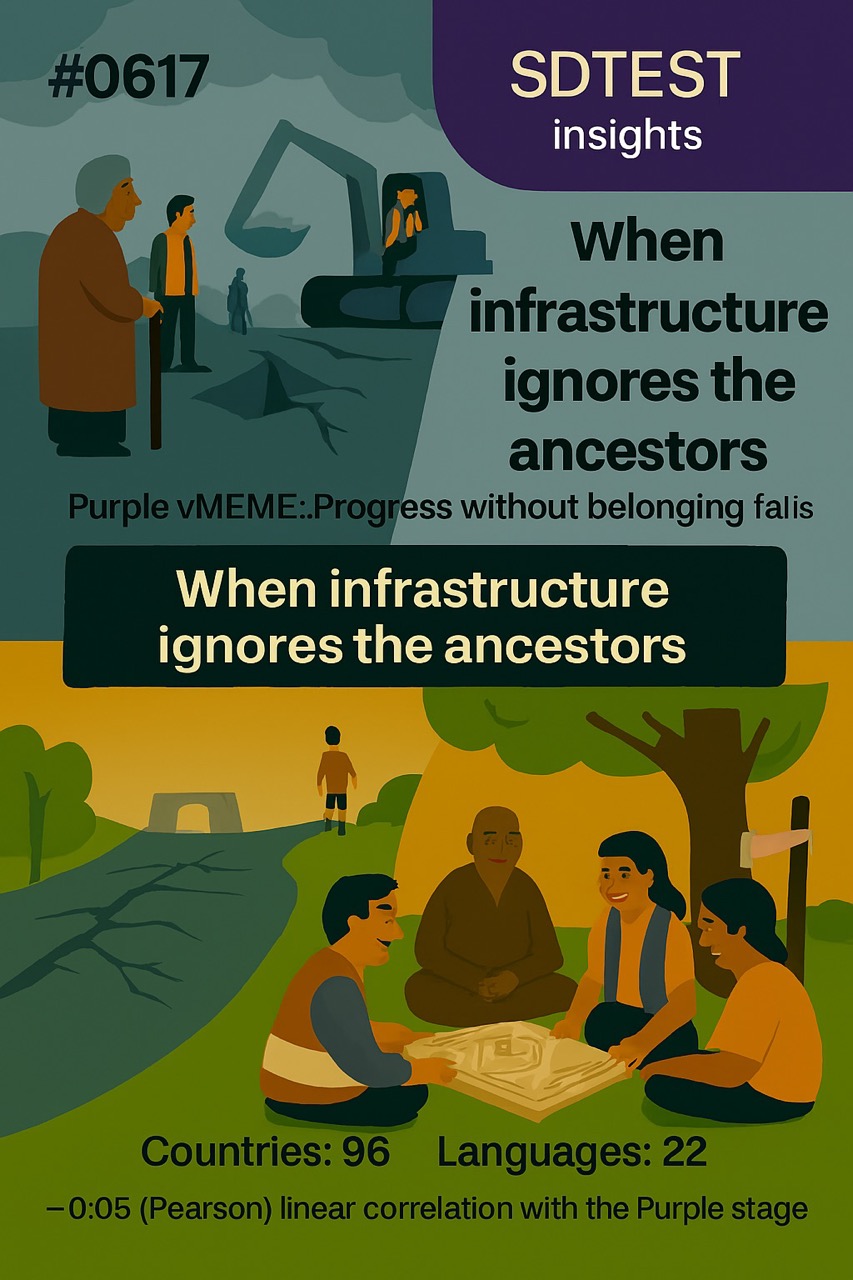
This negative correlation of -0.05 between "Conditions of infrastructure" as the biggest problem facing the country and the Purple stage offers profound insights when viewed through the lens of the Purple value system:
Organizational Perspective:
Organizations operating within the Purple mindset might interpret this correlation as:
- Validation of their ancestral understanding that true national problems stem from spiritual disconnection, violation of sacred traditions, and abandonment of the divine guidance provided by tribal elders and gods
- Confirmation that their traditional wisdom recognizes infrastructure as merely a physical manifestation, while the real challenges facing the nation emerge from supernatural forces and spiritual imbalances that require ritual intervention
- Evidence supporting their belief that focusing on material infrastructure reflects disconnection from the ancestral teachings that identify spiritual corruption and divine displeasure as the root of all national difficulties
These organizations might respond by:
- Implementing traditional ceremonies and rituals to address the spiritual causes underlying national problems, honoring the ancestral wisdom that transcends material concerns about infrastructure
- Establishing leadership structures that prioritize shamanic guidance and elder wisdom in identifying supernatural forces causing national difficulties, rather than focusing on physical infrastructure
- Creating organizational cultures rooted in mythological understanding that recognizes national problems as manifestations of spiritual imbalance requiring traditional healing practices blessed by the gods
Team Perspective:
Teams operating from a Purple mindset might approach this correlation by:
- Viewing it as an affirmation of their tribal understanding that the nation's greatest challenges emerge from violations of sacred taboos and disconnection from ancestral spiritual protection
- Interpreting it as support for their belief that the gods and spirits determine national fate, making infrastructure concerns secondary to spiritual purification and ritual observance
- Seeing it as validation for their community-focused approach that prioritizes restoring harmony with supernatural forces over addressing material infrastructure needs
These teams might respond by:
- Establishing sacred practices where team members engage in collective rituals to address the spiritual roots of national problems through ancestral guidance
- Creating tribal customs that honor the shamanic ability to perceive the supernatural causes of national difficulties beyond material infrastructure concerns
- Developing traditional approaches passed down from community elders that focus on spiritual healing and divine intervention rather than infrastructure improvement
Individual Perspective:
Individuals aligned with the Purple value system might interpret this correlation as:
- Personal validation of their ancestral connection to the mystical understanding that national problems flow from spiritual sources, requiring divine intervention rather than material solutions
- Evidence supporting their belief that their tribal elders and spiritual leaders have taught them to see beyond physical infrastructure to the supernatural forces shaping national destiny
- Confirmation of their understanding that prioritizing infrastructure over spiritual concerns violates the traditional wisdom and sacred teachings of their community
These individuals might respond by:
- Actively participating in traditional spiritual practices and ceremonial rituals that address the divine causes of national problems through ancestral blessing
- Viewing their focus on spiritual rather than infrastructure solutions as evidence of their connection to the sacred wisdom passed down through generations
- Using their understanding of supernatural forces to recognize that national healing requires ritual purification and divine favor rather than infrastructure development
This correlation, viewed through the Purple lens, suggests that those operating at the Purple level recognize national problems as manifestations of spiritual imbalance and supernatural displeasure that transcend material infrastructure concerns.
The reasons why stronger Purple values correlate with less focus on infrastructure conditions as the biggest national problem could include:
- Spiritual Causation: Understanding that national difficulties emerge from supernatural forces, divine displeasure, and spiritual imbalance rather than from material infrastructure deficiencies
- Ancestral Wisdom: Recognition that traditional teachings identify the violation of sacred laws and abandonment of ritual practices as the root causes of national problems
- Divine Intervention: Belief that national fate is determined by gods, spirits, and ancestral guidance rather than by the physical condition of roads, bridges, and utilities
- Supernatural Priorities: Understanding that restoring harmony with spiritual forces and performing proper ceremonies takes precedence over material infrastructure development
- Mythological Perspective: Recognition that national challenges reflect cosmic battles between good and evil forces that require ritual intervention rather than engineering solutions
- Community Focus: Belief that strengthening tribal bonds, honoring elders, and maintaining sacred traditions addresses national problems more effectively than infrastructure improvement
This correlation prompts us to consider how Purple consciousness perceives national challenges through the lens of spiritual and supernatural causation rather than material infrastructure analysis.
Ultimately, this correlation highlights the Purple value system's profound understanding that national problems stem from spiritual sources requiring divine intervention and ancestral guidance.
Infrastructure conditions become secondary concerns when viewed through the Purple perspective that recognizes the gods, spirits, and supernatural forces as the ultimate determinants of national well-being, requiring ritual purification, ceremonial healing, and restoration of harmony with the sacred traditions blessed by tribal elders and ancestral wisdom rather than material infrastructure development.
In our analysis of the poll "Characteristics of a talented employee" (by Talent Management Institute [1]), we found an intriguing negative linear correlation that warrants closer examination:
-0.1435 (Pearson) between the Effective communication and the Red stage.
The critical value of the correlation coefficient for a non-normal distribution, by Spearman, is r = 0.0078. Nevertheless, this negative linear correlation of -0.1435 meets the reliability criteria but does not necessarily imply causation.
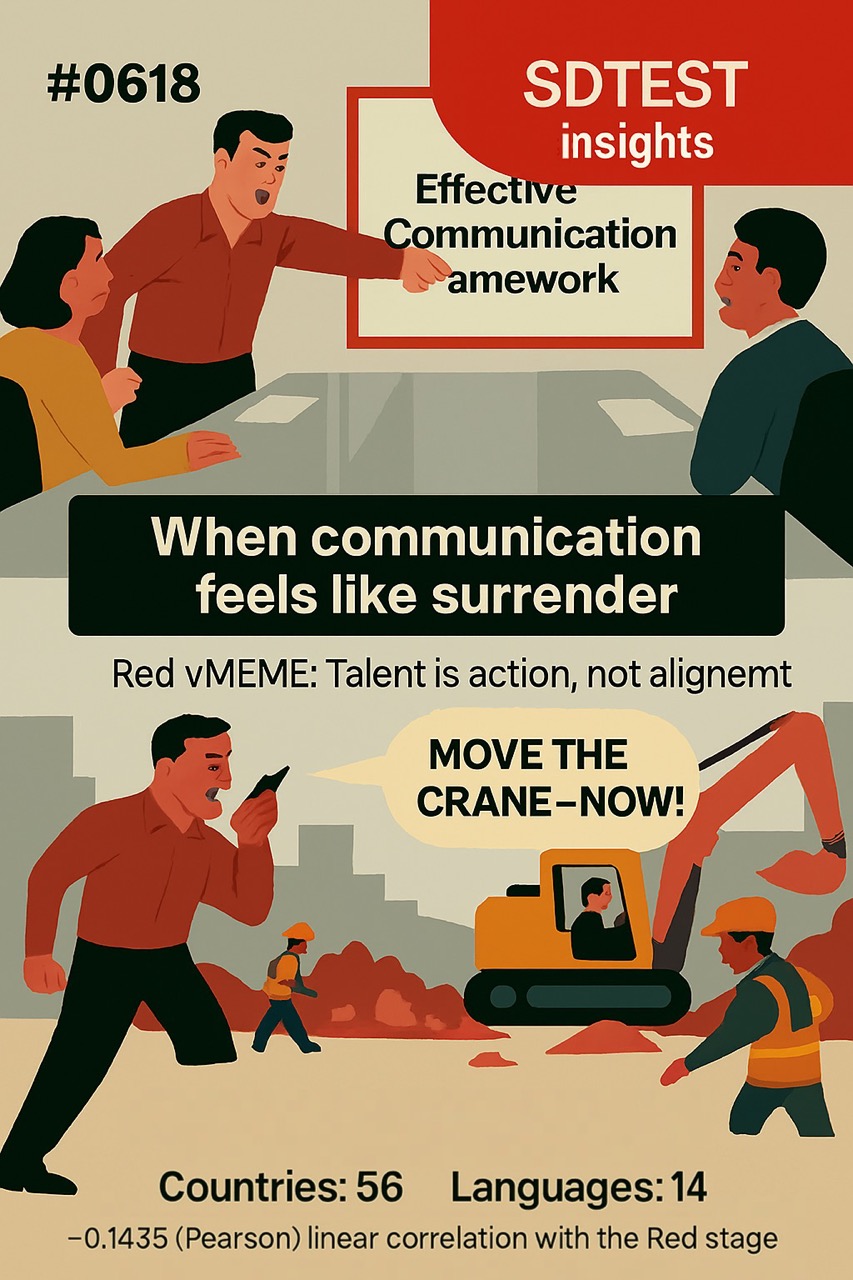
This negative correlation of -0.1435 between "Effective communication" as a characteristic of a talented employee and the Red stage offers intriguing insights when viewed through the lens of the Red value system:
Organizational Perspective:
Organizations operating within the Red mindset might interpret this correlation as:
- Validation of their power-driven approach, where talent is measured by dominance, results, and the ability to impose one's will rather than through collaborative communication skills
- Confirmation that their competitive, force-oriented culture values employees who take decisive action and assert their dominance over those who waste time with excessive communication
- Evidence supporting their belief that effective communication often signals weakness, indecisiveness, and inability to command respect through direct action and personal power
These organizations might respond by:
- Implementing performance metrics that prioritize immediate results, individual conquest, and the ability to dominate situations over communication effectiveness
- Establishing reward systems that favor employees who can force outcomes through personal strength and assertiveness rather than those who rely on communication skills
- Creating competitive hierarchies where talent is identified through displays of power, aggressive achievement, and the ability to win conflicts rather than communicate effectively
Team Perspective:
Teams operating from a Red mindset might approach this correlation by:
- Viewing it as an affirmation of their competitive team dynamic, where talent is demonstrated through individual dominance and the ability to impose one's will on situations
- Interpreting it as support for their belief that effective communication wastes valuable time that could be spent on immediate action and personal achievement
- Seeing it as validation for prioritizing team members who can deliver results through force and personal power over those who focus on communication processes
These teams might respond by:
- Establishing team structures that reward individual conquest and immediate gratification over collaborative communication efforts
- Celebrating team members who can dominate discussions, force decisions, and achieve results through personal assertiveness rather than communication skills
- Creating competitive dynamics where talent is measured by the ability to win arguments and impose solutions rather than communicate effectively with others
Individual Perspective:
Individuals aligned with the Red value system might interpret this correlation as:
- Personal validation of their aggressive, action-oriented approach that prioritizes immediate results and personal dominance over time-consuming communication
- Evidence supporting their belief that their talent lies in their ability to force outcomes and assert their will rather than in collaborative communication skills
- Confirmation that their impulsive, direct approach to getting things done is more valuable than the slower process of effective communication
These individuals might respond by:
- Actively prioritizing immediate action and personal achievement over developing communication skills that they view as a weakness or inefficiency
- Viewing their tendency to dominate rather than communicate as evidence of their superior talent and competitive advantage
- Using their focus on immediate gratification and self-expression to achieve results through force rather than through collaborative communication processes
This correlation, viewed through the Red lens, suggests that those operating at the Red level prioritize individual power, immediate action, and dominance over the collaborative and often time-consuming process of effective communication.
The reasons why effective communication might not be seen as a characteristic of talented employees in the Red stage could include:
- Power Over Persuasion: Red values direct dominance and force over the indirect influence that comes through effective communication, viewing communication as a weaker approach
- Immediate Action Focus: The desire for immediate gratification makes the slower process of effective communication seem inefficient compared to direct, aggressive action
- Individual Achievement Priority: Talent is measured by personal conquest and individual results rather than collaborative skills like communication that depend on others
- Competitive Advantage: Effective communication often involves compromise and consideration of others' views, which Red sees as diluting their competitive edge and personal power
- Weakness Perception: Communication skills may be viewed as signs of inability to impose one's will directly, suggesting weakness rather than talent
- Time Inefficiency: The Red focuses on immediate gratification, makes the time investment required for effective communication seem wasteful when direct action could achieve faster results
This correlation prompts us to consider how different value systems define talent and employee effectiveness. It raises questions about the potential benefits and limitations of a Red approach to talent identification, particularly in contexts where individual achievement and immediate results are prioritized over collaborative effectiveness.
Ultimately, this correlation highlights the Red value system's emphasis on individual power and immediate results over collaborative communication skills. For Red-dominant environments, talented employees are those who can dominate situations, achieve immediate results through personal force, and impose their will effectively, rather than those who invest time in the collaborative and often slower process of effective communication with others.
In our analysis of the poll "AI and the end of civilization" (by Elon Musk), we found an intriguing positive linear correlation that warrants closer examination:
0.0799 (Pearson) between the State should exercise control over the development of the artificial intelligence / Strongly agree and the Blue stage.
The critical value of the correlation coefficient for a normal distribution, by William Sealy Gosset (Student), is r = 0.0698. Nevertheless, this positive linear correlation of 0.0799 meets the reliability criteria but does not necessarily imply causation.
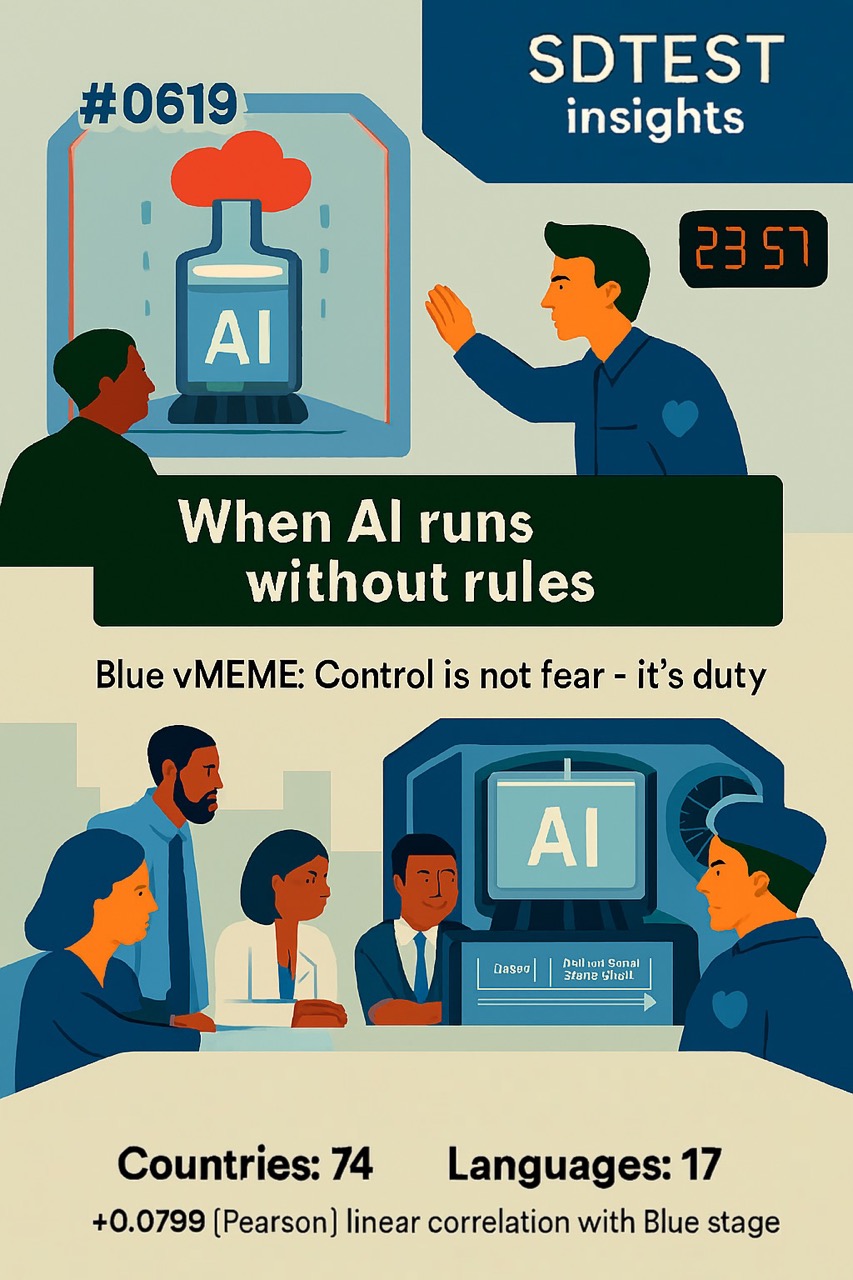
This positive correlation of 0.0799 between "State should exercise control over the development of artificial intelligence / Strongly agree" and the Blue stage offers intriguing insights when viewed through the lens of the Blue value system:
Organizational Perspective:
Organizations operating within the Blue mindset might interpret this correlation as:
- Validation of their traditional, hierarchical approach, where proper authority structures must govern technological development according to established moral codes and divine principles
- Confirmation that their rule-based, disciplined organizational structure recognizes the necessity of higher authority oversight to prevent AI development from violating sacred moral boundaries
- Evidence supporting their belief that unregulated AI development represents a dangerous departure from the orderly, controlled progress that respects traditional values and divine authority
These organizations might respond by:
- Implementing strict compliance frameworks that ensure AI development adheres to established moral codes, regulatory requirements, and traditional ethical principles handed down by higher authorities
- Establishing clear hierarchical oversight structures where AI initiatives must receive approval from proper authorities who can ensure conformity to moral and legal standards
- Creating organizational policies that prioritize duty and responsibility to society over rapid AI innovation, ensuring all technological development serves traditional values and higher purposes
Team Perspective:
Teams operating from a Blue mindset might approach this correlation by:
- Viewing it as an affirmation of their disciplined, rule-following approach that recognizes AI as requiring strict governmental oversight to maintain moral order and social stability
- Interpreting it as support for their belief that proper authorities must control AI development to prevent violations of established moral codes and traditional values
- Seeing it as validation for their loyalty to hierarchical systems that can ensure AI serves the greater good according to divine will and traditional principles
These teams might respond by:
- Establishing team protocols that strictly adhere to governmental regulations and moral guidelines in any AI-related projects or discussions
- Creating collaborative frameworks that prioritize duty to higher authorities and traditional values over individual innovation or competitive advantage in AI development
- Developing team practices that emphasize conformity to established ethical standards and respect for regulatory oversight in technological advancement
Individual Perspective:
Individuals aligned with the Blue value system might interpret this correlation as:
- Personal validation of their disciplined approach to technology that recognizes the need for proper moral authority to govern AI development according to divine will and traditional wisdom
- Evidence supporting their belief that their sense of duty and responsibility leads them to support governmental control over potentially dangerous technological advancement
- Confirmation of their understanding that AI development without proper authority oversight violates the moral order and traditional values they hold sacred
These individuals might respond by:
- Actively supporting governmental policies that establish strict control over AI development to ensure conformity with moral codes and traditional values
- Viewing their preference for state oversight as evidence of their proper moral judgment and loyalty to higher authorities
- Using their strong sense of right and wrong to advocate for regulatory frameworks that prevent AI from violating established moral and social order
This correlation, viewed through the Blue lens, suggests that those operating at the Blue level recognize state control over AI development as a moral imperative necessary to maintain order, tradition, and adherence to higher authority.
The reasons why people strongly agree that the state should exercise control over AI development in the Blue stage could include:
- Moral Authority: Understanding that proper governmental control ensures AI development adheres to moral codes and divine principles handed down by higher authorities
- Traditional Order: Recognition that state oversight maintains the established hierarchical structure and prevents technological chaos that could disrupt traditional social order
- Divine Will: Belief that governmental authority represents a divine mandate to control technological development according to sacred moral principles and traditional wisdom
- Duty and Responsibility: Understanding that supporting state control reflects proper civic duty and moral responsibility to protect society from unregulated technological dangers
- Conformity to Law: Recognition that AI development must conform to established legal and moral frameworks rather than proceed according to individual or corporate desires
- Conservative Wisdom: Appreciation for a cautious, regulated approach that respects traditional values over rapid, uncontrolled technological innovation
- Social Protection: Belief that proper authorities must protect society from AI developments that might violate moral codes or threaten traditional social structures
This correlation prompts us to consider how Blue consciousness values regulatory oversight, moral authority, and traditional order in technological development. It raises questions about how governmental control can ensure AI serves higher moral purposes and maintains social stability.
Ultimately, this correlation highlights the Blue value system's deep trust in hierarchical authority and moral regulation. For Blue-oriented individuals, state control over AI development represents not governmental overreach but proper moral stewardship that ensures technological advancement serves divine will, respects traditional values, and maintains the orderly progress that protects society from the potential moral and social chaos of unregulated artificial intelligence development.
In our analysis of the poll "What makes people successful at work?", we found an intriguing negative linear correlation that warrants closer examination:
-0.0687 (Pearson) between the Honesty and the Orange stage.
The critical value of the correlation coefficient for a normal distribution, by William Sealy Gosset (Student), is r = 0.0364. Nevertheless, this negative linear correlation of -0.0687 meets the reliability criteria but does not necessarily imply causation.
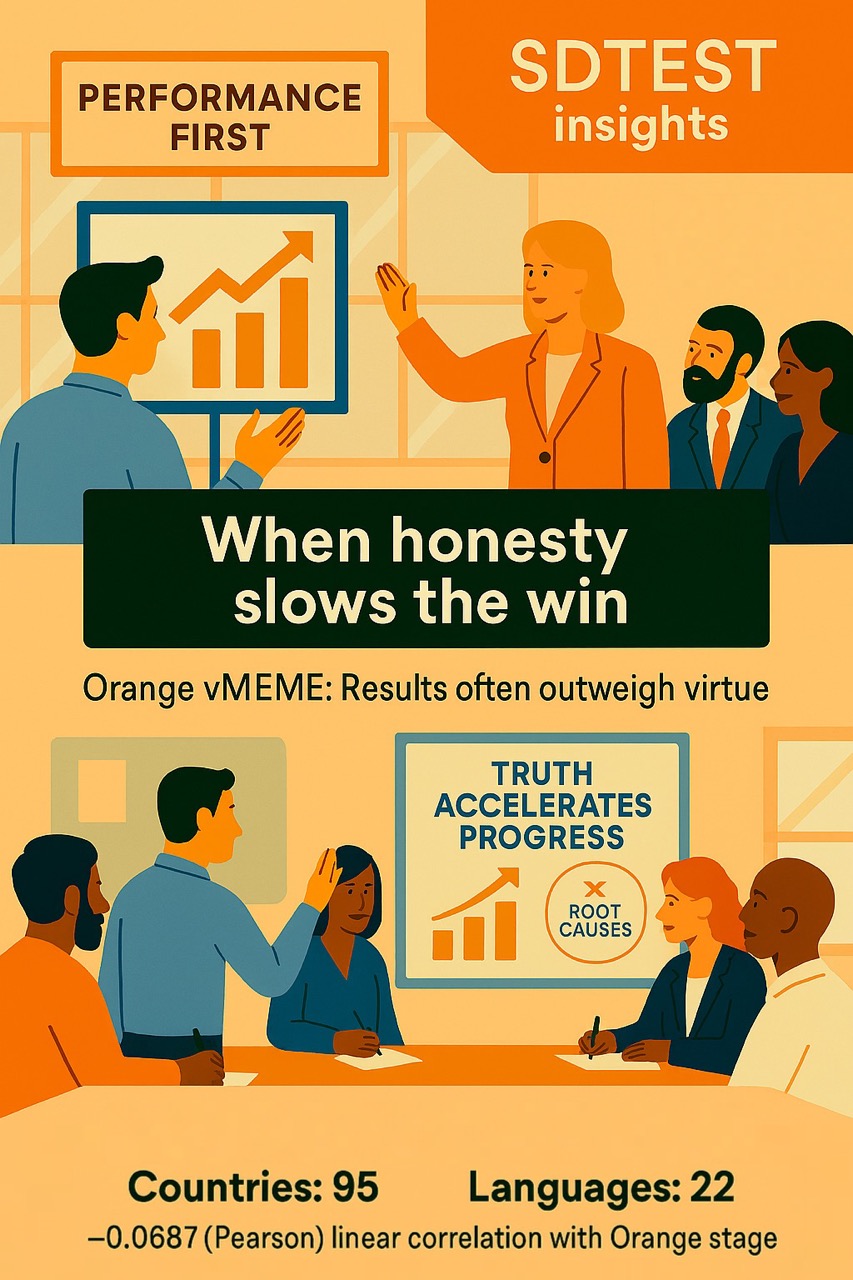
This negative correlation of -0.0687 between "Honesty" as what makes people successful at work and the Orange stage offers intriguing insights when viewed through the lens of the Orange value system:
Organizational Perspective:
Organizations operating within the Orange mindset might interpret this correlation as:
- Validation of their rational, results-driven approach, where success is measured by objective achievements, competitive advantage, and strategic positioning rather than adherence to abstract moral concepts like honesty
- Confirmation that their scientific, efficiency-focused culture prioritizes data-driven decision-making, technological innovation, and measurable outcomes over traditional ethical considerations that may impede progress
- Evidence supporting their belief that workplace success emerges from analytical thinking, strategic intelligence, and competitive skills rather than from moral virtues that lack empirical correlation with performance metrics
These organizations might respond by:
- Implementing performance evaluation systems that prioritize quantifiable results, innovative solutions, and competitive achievements over subjective character assessments like honesty
- Establishing reward structures that favor employees who can deliver measurable outcomes, technological breakthroughs, and strategic advantages regardless of their adherence to traditional moral frameworks
- Creating organizational cultures that value rational decision-making, scientific problem-solving, and efficiency optimization over ethical considerations that may constrain competitive performance
Team Perspective:
Teams operating from an Orange mindset might approach this correlation by:
- Viewing it as an affirmation of their analytical, goal-oriented approach that recognizes success through technical competence, strategic thinking, and results achievement rather than moral characteristics
- Interpreting it as support for their belief that team effectiveness comes from rational collaboration, data-driven decisions, and competitive performance rather than adherence to honesty as a success factor
- Seeing it as validation for prioritizing scientific methods, logical analysis, and efficiency in team dynamics over traditional values that lack empirical support for workplace success
These teams might respond by:
- Establishing team metrics that focus on measurable achievements, innovative solutions, and competitive advantages rather than subjective moral evaluations like honesty
- Creating collaborative frameworks that emphasize analytical problem-solving, technological proficiency, and strategic thinking as the primary drivers of team success
- Developing team practices that prioritize rational discourse, data-based decisions, and efficiency optimization over traditional character-based team building approaches
Individual Perspective:
Individuals aligned with the Orange value system might interpret this correlation as:
- Personal validation of their rational, achievement-oriented approach that prioritizes scientific thinking, competitive skills, and measurable results over traditional moral frameworks
- Evidence supporting their belief that their success stems from analytical capabilities, technological proficiency, and strategic intelligence rather than adherence to honesty as a character trait
- Confirmation of their understanding that workplace advancement requires rational decision-making, competitive advantage, and results-driven performance rather than moral considerations
These individuals might respond by:
- Actively developing their analytical skills, technological competence, and strategic thinking abilities as the primary drivers of career success
- Viewing their focus on rational achievement and competitive performance as more valuable than traditional character traits like honesty
- Using their scientific mindset to optimize their career advancement through data-driven strategies, efficiency improvements, and results-oriented approaches
This correlation, viewed through the Orange lens, suggests that those operating at the Orange level recognize workplace success as emerging from rational capabilities, competitive performance, and measurable achievements rather than from traditional moral virtues like honesty.
The reasons why honesty might be less prioritized as a success factor in the Orange stage could include:
- Empirical Focus: Orange values measurable, quantifiable success factors over subjective moral traits that cannot be scientifically validated or objectively assessed
- Competitive Advantage: Success is viewed as emerging from strategic intelligence, analytical thinking, and competitive skills rather than from moral character that may constrain competitive positioning
- Rational Optimization: The focus on efficiency and results may prioritize pragmatic decision-making over strict adherence to honesty when it conflicts with optimal outcomes
- Scientific Skepticism: Orange consciousness questions traditional moral frameworks, preferring evidence-based approaches to success that rely on data rather than ethical principles
- Individual Achievement: Success is measured by personal accomplishment, technological innovation, and career advancement rather than by adherence to traditional social virtues
- Progress Orientation: The drive for advancement and modernization may view traditional moral constraints like absolute honesty as obstacles to necessary progress and innovation
This correlation prompts us to consider how Orange consciousness redefines workplace success through rational, scientific, and competitive frameworks rather than traditional moral categories. It raises questions about how analytical thinking and results-oriented approaches shape perceptions of what drives professional achievement.
Ultimately, this correlation highlights the Orange value system's emphasis on rational, measurable success factors over traditional moral virtues. For Orange-oriented individuals, workplace success emerges from analytical capabilities, technological proficiency, competitive intelligence, and results-driven performance rather than from adherence to honesty, reflecting their scientific, efficiency-focused approach to professional achievement that prioritizes empirical outcomes over traditional character-based success models.
In our analysis of the poll "What makes a boss a great leader?", we found an intriguing positive linear correlation that warrants closer examination:
0.1061 (Pearson) between the Empathy and the Green stage.
The critical value of the correlation coefficient for a normal distribution, by William Sealy Gosset (Student), is r = 0.039. Nevertheless, this positive linear correlation of 0.1061 meets the reliability criteria but does not necessarily imply causation.
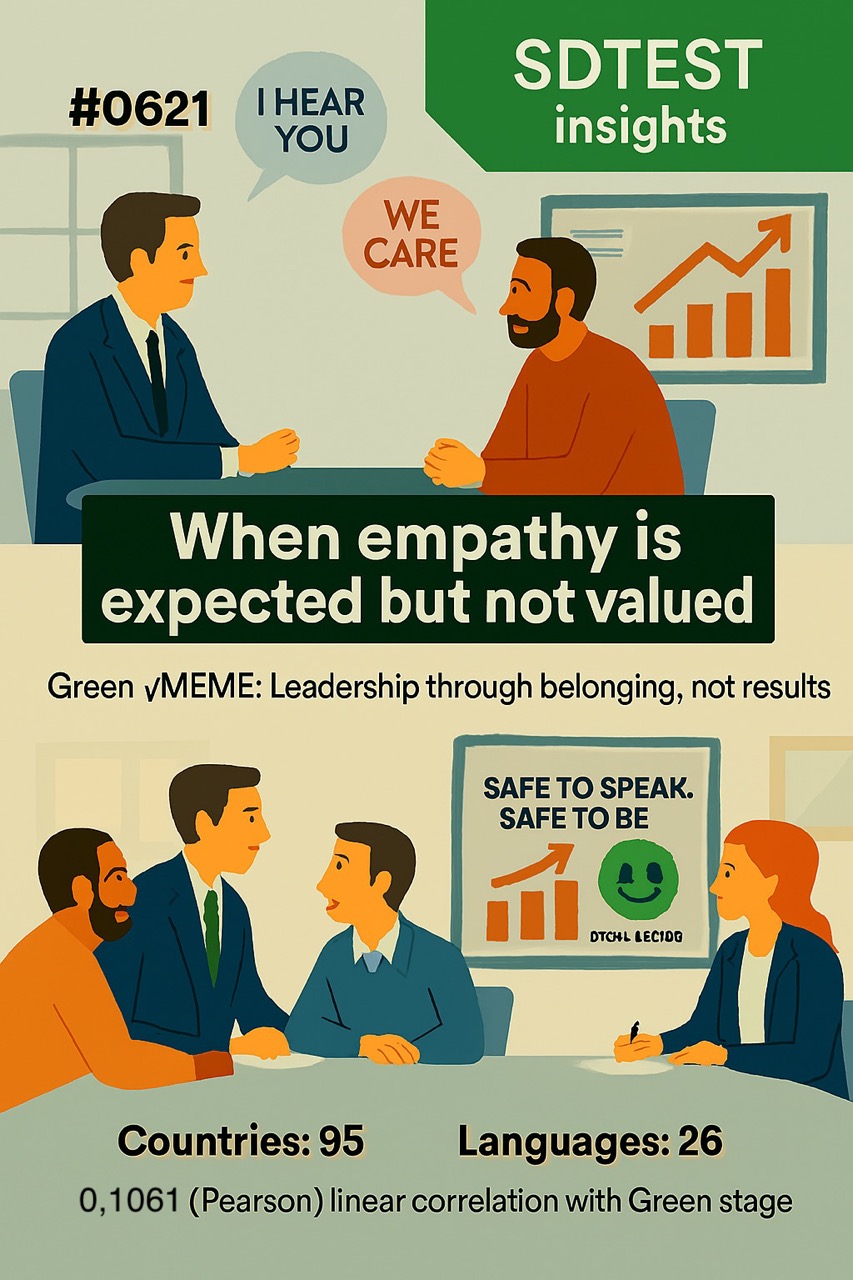
This positive correlation of 0.1061 between "Empathy" as what makes a boss a great leader and the Green stage offers profound insights when viewed through the lens of the Green value system:
Organizational Perspective:
Organizations operating within the Green mindset might interpret this correlation as:
- Validation of their holistic, people-centered approach to leadership that recognizes empathy as essential for understanding the interconnected well-being of all stakeholders within organizational ecosystems
- Confirmation that their systems-thinking approach correctly identifies empathy as the foundation for sustainable leadership that honors community needs, environmental impact, and collective flourishing
- Evidence supporting their belief that great leadership emerges from a compassionate understanding of diverse perspectives and commitment to the well-being of all organizational members, rather than hierarchical authority
These organizations might respond by:
- Implementing comprehensive leadership development programs that prioritize empathetic awareness, emotional intelligence, and systems thinking as core competencies for sustainable organizational success
- Establishing leadership selection criteria that emphasize candidates' ability to understand and respond to diverse stakeholder needs, environmental concerns, and community well-being
- Creating organizational cultures that measure leadership effectiveness through empathetic engagement, collaborative decision-making, and positive impact on collective flourishing rather than traditional performance metrics
Team Perspective:
Teams operating from a Green mindset might approach this correlation by:
- Viewing it as an affirmation of their collaborative, consensus-building approach that recognizes empathetic leadership as essential for honoring all team members' voices and perspectives
- Interpreting it as support for their belief that great team leadership emerges from a deep understanding of individual needs, collective dynamics, and the interconnected impact of team decisions
- Seeing it as validation for their inclusive, participatory team culture that values leaders who can create psychological safety through empathetic presence and compassionate understanding
These teams might respond by:
- Establishing leadership roles that rotate among team members based on their capacity for empathetic understanding and ability to facilitate inclusive, collaborative processes
- Creating team development practices that cultivate empathetic awareness, emotional attunement, and systems thinking as essential leadership qualities for collective success
- Developing team cultures that celebrate leaders who demonstrate deep listening, compassionate response, and commitment to the well-being of all team members and stakeholders
Individual Perspective:
Individuals aligned with the Green value system might interpret this correlation as:
- Personal validation of their empathetic, community-oriented approach to leadership that prioritizes understanding and responding to the needs of all people within their sphere of influence
- Evidence supporting their belief that their compassionate, systems-aware leadership style creates a positive impact on collective well-being and sustainable organizational success
- Confirmation of their understanding that great leadership flows from authentic care for others, emotional intelligence, and commitment to creating inclusive, supportive environments
These individuals might respond by:
- Actively cultivating their empathetic awareness, emotional intelligence, and capacity for deep listening as essential leadership development practices
- Viewing their empathetic leadership approach as evidence of their evolved consciousness and commitment to collective flourishing and sustainability
- Using their understanding of interconnectedness to develop leadership practices that honor diverse perspectives, support individual growth, and contribute to community well-being
This correlation, viewed through the Green lens, suggests that those operating at the Green level recognize empathy as the foundational quality that enables leaders to understand, support, and effectively guide diverse groups toward collective flourishing and sustainable success.
The reasons why Empathy makes a boss a great leader in the Green stage could include:
- Systems Understanding: Recognition that empathy enables leaders to understand the complex interconnections between individual needs, team dynamics, and organizational impact on broader communities
- Inclusive Leadership: Understanding that empathetic leaders can honor diverse perspectives, create psychological safety, and facilitate collaborative decision-making that serves collective well-being
- Sustainable Relationships: Awareness that empathy builds the trust, connection, and mutual support necessary for long-term organizational sustainability and positive impact
- Holistic Awareness: Recognition that empathetic leaders can perceive and respond to the emotional, environmental, and social dimensions that affect organizational effectiveness
- Community Building: Understanding that empathy creates the foundation for authentic community, collaborative culture, and shared commitment to collective flourishing
- Transformative Impact: Belief that empathetic leadership transforms organizational culture by modeling compassion, inclusivity, and commitment to the well-being of all stakeholders
- Evolutionary Consciousness: Recognition that empathetic leadership represents an evolution beyond hierarchical authority toward collaborative, community-centered approaches to organizational guidance
This correlation prompts us to consider how Green consciousness transforms leadership from individual authority to empathetic facilitation of collective wisdom and community flourishing. It raises questions about how empathetic leadership practices can create more sustainable, inclusive, and effective organizational cultures.
Ultimately, this correlation highlights the Green value system's profound understanding that great leadership emerges from empathetic connection, systems awareness, and genuine commitment to collective well-being. For Green-oriented organizations, empathy becomes not merely a leadership skill but the essential quality that enables leaders to understand diverse needs, facilitate inclusive collaboration, and guide communities toward sustainable success that honors the interconnected well-being of all people, communities, and environmental systems within their sphere of influence.
In our analysis of the poll "Does ageism exist?", we found an intriguing positive linear correlation that warrants closer examination:
0.1155 (Pearson) between the Yes, ageism exists within my family and community, and the Yellow stage.
The critical value of the correlation coefficient for a normal distribution, by William Sealy Gosset (Student), is r = 0.073. Nevertheless, this positive linear correlation of 0.1155 meets the reliability criteria but does not necessarily imply causation.
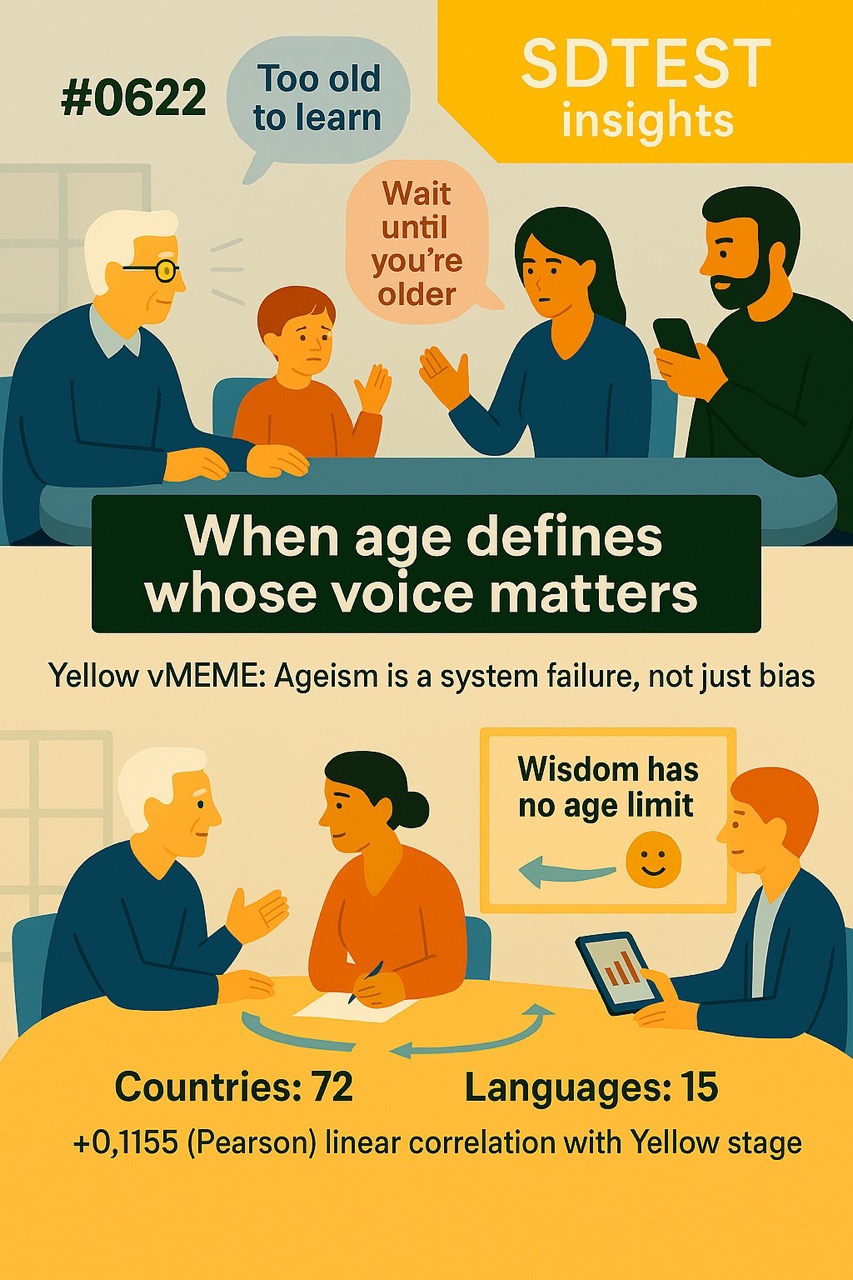
This positive correlation of 0.1155 between "Yes, ageism exists within my family and community" and the Yellow stage offers profound insights when viewed through the lens of the Yellow value system:
Organizational Perspective:
Organizations operating within the Yellow mindset might interpret this correlation as:
- Validation of their meta-systemic awareness that recognizes ageism as a complex, multi-dimensional phenomenon operating across developmental stages and requiring integrative analysis to perceive and address effectively
- Confirmation that their capacity for integral thinking allows them to see beyond surface-level diversity initiatives to identify subtle, systemic patterns of age-related bias that less developed organizational consciousness often overlooks
- Evidence supporting their belief that acknowledging ageism reflects sophisticated developmental awareness capable of transcending the cognitive limitations that prevent earlier value systems from recognizing their own age-related biases
These organizations might respond by:
- Implementing comprehensive diagnostic frameworks that use Yellow consciousness to identify age-related biases operating across multiple organizational levels and value system perspectives
- Creating meta-systemic approaches to organizational development that integrate insights from all developmental stages to address ageism as a complex, evolutionary challenge
- Developing organizational cultures that leverage their integrative awareness to model recognition and resolution of systemic biases that less developmentally advanced organizations cannot perceive
Team Perspective:
Teams operating from a Yellow mindset might approach this correlation by:
- Viewing it as an affirmation of their meta-cognitive ability to recognize age-related biases that operate across different developmental perspectives within team dynamics
- Interpreting it as support for their belief that acknowledging ageism requires the developmental sophistication to transcend single-perspective thinking and see systemic patterns
- Seeing it as validation for their integrative approach that can simultaneously hold multiple perspectives on age-related dynamics while recognizing the shadow aspects of all developmental stages
These teams might respond by:
- Establishing team protocols that use their Yellow consciousness to identify and address age-related biases operating at multiple levels of team interaction and decision-making
- Creating collaborative frameworks that integrate insights from different generational perspectives while maintaining awareness of how each developmental stage might contribute to ageist patterns
- Developing team practices that model the meta-cognitive awareness necessary for recognizing and transforming subtle age-related biases that less developed team consciousness cannot perceive
Individual Perspective:
Individuals aligned with the Yellow value system might interpret this correlation as:
- Personal validation of their meta-cognitive capacity to recognize age-related biases that operate within their own developmental journey and family systems
- Evidence supporting their understanding that acknowledging ageism requires the integrative consciousness to see beyond their own developmental perspective and recognize systemic patterns
- Confirmation of their ability to hold paradox and complexity when examining how age-related biases manifest across different value systems and family dynamics
These individuals might respond by:
- Actively using their meta-cognitive awareness to identify and address age-related biases within their own thinking patterns and family relationships
- Viewing their recognition of ageism as evidence of their developmental sophistication and commitment to integral personal growth
- Using their understanding of spiral dynamics to help family and community members develop the awareness necessary to recognize and transform age-related biases
This correlation, viewed through the Yellow lens, suggests that those operating at the Yellow level possess the meta-cognitive sophistication necessary to recognize ageism as a complex, systemic phenomenon that operates across multiple developmental stages and requires integrative awareness to perceive and address effectively.
The reasons why people say that ageism exists within their family and community in the Yellow stage could include:
- Meta-Cognitive Awareness: Understanding that their developmental sophistication enables them to perceive age-related biases that less developed consciousness cannot recognize within familiar systems
- Systems Integration: Recognition that ageism operates as a complex, multi-dimensional phenomenon requiring integrative thinking to identify patterns across different developmental perspectives
- Shadow Integration: Ability to acknowledge the shadow aspects of their own developmental journey and family systems, including recognition of age-related biases they might have previously overlooked
- Developmental Perspective: Understanding that different value systems within families and communities each contribute unique forms of age-related bias that require sophisticated analysis to perceive
- Paradox Tolerance: Capacity to hold the complexity that familiar systems can simultaneously provide support and perpetuate subtle forms of discrimination
- Integral Honesty: Willingness to acknowledge uncomfortable truths about systemic biases within intimate relationships rather than maintaining idealized perspectives
- Evolutionary Responsibility: Recognition that their developmental sophistication creates responsibility to identify and address systemic biases that contribute to collective evolutionary growth
This correlation prompts us to consider how Yellow consciousness enables recognition of subtle, systemic biases that operate within familiar contexts where emotional attachment might prevent less developed awareness from perceiving discriminatory patterns.
Ultimately, this correlation highlights the Yellow value system's capacity for what we might call "integral honesty," the meta-cognitive sophistication to recognize age-related biases within their own family and community systems. This recognition emerges not from cynicism but from developmental maturity that can hold the paradox of love and bias simultaneously, using integrative awareness to identify systemic patterns that require conscious evolution rather than defensive denial.
In our analysis of the poll "Reasons why people give up" (by Anna Vital [2]), we found an intriguing negative linear correlation that warrants closer examination:
-0.0614 (Pearson) between the Expect fast results and the Turquoise stage.
The critical value of the correlation coefficient for a normal distribution, by William Sealy Gosset (Student), is r = 0.0524. Nevertheless, this negative linear correlation of -0.0614 meets the reliability criteria but does not necessarily imply causation.

This negative correlation of -0.0614 between "Expect fast results" as a reason why people give up, and the Turquoise stage offers profound insights when viewed through the lens of the Turquoise value system:
Organizational Perspective:
Organizations operating within the Turquoise mindset might interpret this correlation as:
- Validation of their holistic understanding that meaningful transformation occurs within natural cycles and evolutionary timeframes that honor the interconnected complexity of all systems
- Confirmation that their ecological perspective recognizes sustainable change as emerging through organic processes that respect the interdependence of human, organizational, and planetary rhythms
- Evidence supporting their belief that expecting fast results reflects disconnection from the natural flow of evolutionary development and the cosmic timing that governs authentic transformation
These organizations might respond by:
- Implementing comprehensive development frameworks that honor natural cycles, seasonal rhythms, and the evolutionary timeframes necessary for sustainable organizational transformation
- Creating organizational cultures that celebrate patience, persistence, and alignment with natural processes over artificial urgency and disconnected speed expectations
- Developing strategic approaches that integrate long-term ecological thinking, spiritual wisdom, and cosmic perspective into organizational planning and goal-setting processes
Team Perspective:
Teams operating from a Turquoise mindset might approach this correlation by:
- Viewing it as an affirmation of their understanding that collective evolution occurs through natural processes that require patience, presence, and attunement to the sacred timing of group development
- Interpreting it as support for their belief that meaningful team transformation emerges through organic collaboration that honors the interconnected growth of all members within the larger web of relationships
- Seeing it as validation for their holistic approach that recognizes team success as flowing from alignment with natural rhythms rather than from imposed expectations of rapid achievement
These teams might respond by:
- Establishing collaborative practices that honor the sacred timing of collective development, allowing natural processes to guide team evolution and transformation
- Creating team cultures that celebrate the journey of shared growth, recognizing that meaningful change occurs through patient cultivation of authentic relationships and spiritual connection
- Developing team practices that integrate contemplative awareness, ecological wisdom, and cosmic perspective into collective goal-setting and achievement processes
Individual Perspective:
Individuals aligned with the Turquoise value system might interpret this correlation as:
- Personal validation of their holistic understanding that authentic personal development occurs through alignment with natural rhythms, spiritual timing, and evolutionary consciousness
- Evidence supporting their belief that their patient, contemplative approach to growth reflects their connection to cosmic timing and natural cycles of transformation
- Confirmation of their recognition that expecting fast results represents disconnection from the sacred flow of life and the evolutionary processes that govern authentic development
These individuals might respond by:
- Actively cultivating patience, presence, and attunement to natural cycles as essential practices for authentic personal and spiritual development
- Viewing their patient approach to growth as evidence of their alignment with cosmic consciousness and ecological wisdom
- Using their understanding of interconnectedness to recognize that personal transformation occurs within the larger web of planetary and universal evolution
This correlation, viewed through the Turquoise lens, suggests that those operating at the Turquoise level recognize that expecting fast results reflects disconnection from the natural flow of evolutionary development and the sacred timing that governs authentic transformation.
The reasons why "Expect fast results" is not a reason why people give up in the Turquoise stage could include:
- Natural Timing Awareness: Understanding that authentic transformation occurs according to natural cycles, evolutionary processes, and sacred timing that cannot be artificially accelerated
- Ecological Consciousness: Recognition that sustainable change follows organic patterns of growth that honor the interconnected complexity of all living systems
- Cosmic Perspective: Awareness that individual and collective development occur within larger evolutionary cycles that transcend immediate expectations and artificial timelines
- Spiritual Patience: Understanding that meaningful growth emerges through contemplative presence and alignment with the sacred flow of life rather than through urgency
- Interconnected Evolution: Recognition that personal transformation is inseparable from collective and planetary evolution, requiring patience with complex, interdependent processes
- Process Orientation: Belief that the journey of development is as important as outcomes, requiring presence and appreciation for each stage of evolutionary unfolding
- Sacred Timing: Understanding that the universe has its own wisdom about timing, and that forcing rapid results disrupts the natural harmony necessary for authentic transformation
This correlation prompts us to consider how Turquoise consciousness transforms the relationship with time, patience, and the natural flow of evolutionary development. It raises questions about how ecological and cosmic awareness might inform more sustainable approaches to personal and collective transformation.
Ultimately, this correlation highlights the Turquoise value system's profound integration with natural cycles, cosmic timing, and evolutionary consciousness. For Turquoise-oriented individuals, the expectation of fast results represents disconnection from the sacred flow of life rather than a source of discouragement, as they understand that authentic transformation occurs through patient alignment with the evolutionary processes that govern the interconnected web of existence, honoring both personal development and planetary healing within the larger context of cosmic evolution and universal consciousness.
What insights do you gain from today's correlation? How might we study this relationship more carefully before deducing causation?
We welcome respectful and wise perspectives! Stay tuned every week as we share more results and insights.
After login or registration, free access to the poll results in the FAQ section.
[1] www.linkedin.com/company/talent-management-institute
[2] www.linkedin.com/in/annavital
2025.09.14
FearpersonqualitiesprojectorganizationalstructureRACIresponsibilitymatrixCritical ChainProject Managementfocus factorJiraempathyleadersbossGermanyChinaPolicyUkraineRussiawarvolatilityuncertaintycomplexityambiguityVUCArelocatejobproblemcountryreasongive upobjectivekeyresultmathematicalpsychologyMBTIHR metricsstandardDEIcorrelationriskscoringmodelGame TheoryPrisoner's Dilemma
Valerii Kosenko
Produkteier SaaS SDTEST®
Valerii ble utdannet sosialpedagog-psykolog i 1993 og har siden brukt sin kunnskap innen prosjektledelse.
Valerii oppnådde en Mastergrad og prosjekt- og programlederkvalifikasjonen i 2013. I løpet av masterstudiet ble han kjent med Project Roadmap (GPM Deutsche Gesellschaft für Projektmanagement e. V.) og Spiral Dynamics.
Valerii er forfatteren av å utforske usikkerheten til V.U.C.A. konsept ved hjelp av Spiral Dynamics og matematisk statistikk i psykologi, og 38 internasjonale meningsmålinger.








